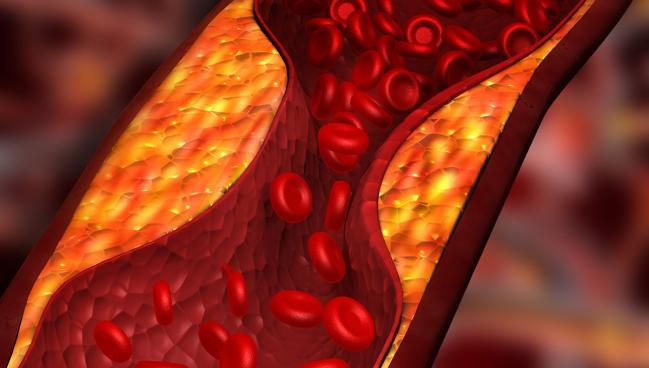Atherosclerosis Progression May Share Traits With Tumor Growth
Although the concept isn’t new, a recent study provides insight into mechanisms—and hints at novel ways to tackle residual risk.

The progression of atherosclerosis, at a cellular level, is reminiscent of the processes involved in tumor growth, new research confirms.
Importantly, the idea itself is not new—but until now, the mechanisms were poorly understood, Huize Pan, PhD (Vanderbilt University Medical Center, Nashville, TN), and colleagues note in Circulation. “Indeed, researchers hypothesized at least two decades ago that atherosclerosis represented a tumor-like state of the arterial wall,” wherein smooth-muscle cells (SMCs) “proliferate, migrate, and transdifferentiate into other cell types in atherosclerotic lesions,” they note.
Muredach P. Reilly, MBBCh, MSCE (NewYork-Presbyterian/Columbia University Irving Medical Center, New York, NY), senior author of the recent study, told TCTMD that the findings tie into residual risk—those excess events that can still occur even when medical therapy and interventions are used to address conventional CVD risk factors like elevated LDL cholesterol and blood pressure. “That is an unmet need and probably a therapeutic opportunity,” said Reilly.
Here, the researchers sought specifically to understand the tumor-like characteristics of SMCs in atherosclerosis by applying modern “molecular, cellular, histological, computational, human genetics, and pharmacological approaches.”
Reilly pointed out that there’s a precedent: clonal hematopoiesis, where bone marrow-derived myeloid cells begin to behave in a cancer-like way, is a known example illustrating the intersection between tumor growth and cardiovascular disease.
“Those cells get recruited to the blood vessel wall much more actively than normal cells. They expand clonally in the vessel wall, and they accelerate atherosclerosis in mouse models. When you have those clonal mutations, they’re associated with higher rates of cardiovascular disease in humans,” he noted. “That’s one nontraditional path that suggests in patients with established disease who are older. . . there is this mechanism that is independent of lipids, independent of traditional risk factors, but [that] drives abnormal macrophage and platelet function and accelerates events.”
In the current study of SMCs, they had the benefit of “technologies for profiling of individual cells and lesions combined with lineage tracing in mouse models, where we’re actually able to identify smooth-muscle cells and importantly the smooth-muscle-derived cells,” said Reilly, who added that such cells likely make up the majority of those in atherosclerotic plaque.
He stressed that this phenomenon is more akin to benign tumor cells than metastatic cancer: “They don’t invade and leave the blood vessel wall [but instead are] proliferating and behaving abnormally.”
Although a long road of research lies ahead, it might one day be possible to use anticancer drugs as therapies to reduce progression of atherosclerosis, Reilly suggested. Or, if the genetic roots of SMC mutations are better understood, this might uncover opportunities for precision medicine tailored to particular patients, he added.
Smooth-Muscle Cells
Led by Pan, the researchers conducted numerous experiments using SMCs in mice as well as in human tissues.
They found evidence that when SMCs switched phenotypes in the process of becoming other cell types, specific DNA damage occurred in those lineage cells. Moreover, this damage was associated with DNA breaks in the SMCs, which had been tagged with markers to ensure the investigators could track the cells’ paths over time.
“Almost all cell types in mouse lesions, especially smooth-muscle-cell-derived cells”—stem cells, endothelial cells, and monocytes, as well as fibrochondrocytes—“showed extensive genomic CNVs,” or copy number variations, they explain. Further analyses suggested that genomic instability (ie, greater tendency toward genetic changes) seen in “SMC lineage cells in human atherosclerosis is linked to amplification of genes associated with coronary artery disease and cancer.”
Additional tests captured evidence of tumor cell-like qualities like “evasion of senescence, hyperproliferation, resistance to cell death, invasiveness, and activation of comprehensive cancer-associated gene regulatory networks,” the researchers report. And finally, other experiments found that the oncogenic mutant KRAS G12D, when expressed in mice, “accelerates phenotypic switching and exacerbates atherosclerosis.”
Pan and colleagues also looked at the effects of niraparib (Zejula; GlaxoSmithKline), a drug aimed at repairing DNA damage that’s typically used to treat certain ovarian, fallopian tube, or primary peritoneal cancers. In mouse models, they found, niraparib slowed down the progression of atherosclerosis and induced regression of lesions in advanced disease.
“Our findings demonstrate that atherosclerosis is an SMC-driven tumor-like disease, advancing our understanding of its pathogenesis and opening prospects,” the researchers conclude.
For the prospect of using anticancer therapies to combat CVD, there’s the question of why prior trials in the oncology space haven’t picked up on a decrease in atherosclerosis with medications that affect SMCs.
“If you’re not looking for it, you won’t see it,” said Reilly. “None of these trials for cancer are designed [to] have a sample size that is adequate to assess cardiovascular risk. So, you would only see cardiovascular risk increases or reductions that were very profound, and we do see some of that—some drugs for cancer activate platelets, activate the endothelium, and cause events.”
Large real-world datasets could be used to ascertain whether there’s any observational signal that cancer therapies indeed reduce CVD, he added. “We really don’t know until we give it more attention.”
Caitlin E. Cox is News Editor of TCTMD and Associate Director, Editorial Content at the Cardiovascular Research Foundation. She produces the…
Read Full BioSources
Pan H, Ho SE, Xue C, et al. Atherosclerosis is a smooth muscle cell–driven tumor-like disease. Circulation. 2024;Epub ahead of print.
Disclosures
- Pan and Reilly report no relevant conflicts of interest.





Comments